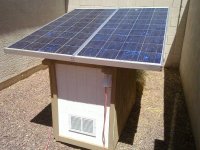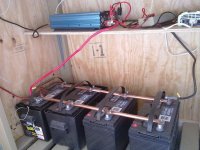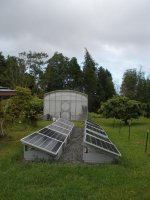John in CR
100 TW
What I'd really like to do is make a sizable but very light flatbed-like trailer, big enough for a couple of passengers, and set it up to be pulled by a high power ebike. The trailer would contain plenty of batteries, and have a drive motor with very low gearing to assist up big hills. Build my 500W of solar cells into panels that stow in the flatbed during transit, or maybe form an aerodynamic shell.
Zip down to the beach with the bike and trailer. Disconnect the trailer from the bike and install a front wheel with handlebars transforming the trailer into a low speed cargo trike, and free the bike up for fun riding. After loading up the ice chest(s), cruise the trike down to set up with the solar panels doubling as a roof or canopy for shade. The solar panels keep the big battery bank charged for a stereo system and to recharge the bike as needed. A genny made with a weedeater motor and an RC motor would be a great emergency backup power source.
If I build the trailer with pop-up camper type features it can also be sleeping quarters. About the only thing I can think of to add to the capabilities is easily removable wheels and total waterproofing, so the trailer is also an electric catamaran to take out on the water.
Zip down to the beach with the bike and trailer. Disconnect the trailer from the bike and install a front wheel with handlebars transforming the trailer into a low speed cargo trike, and free the bike up for fun riding. After loading up the ice chest(s), cruise the trike down to set up with the solar panels doubling as a roof or canopy for shade. The solar panels keep the big battery bank charged for a stereo system and to recharge the bike as needed. A genny made with a weedeater motor and an RC motor would be a great emergency backup power source.
If I build the trailer with pop-up camper type features it can also be sleeping quarters. About the only thing I can think of to add to the capabilities is easily removable wheels and total waterproofing, so the trailer is also an electric catamaran to take out on the water.





